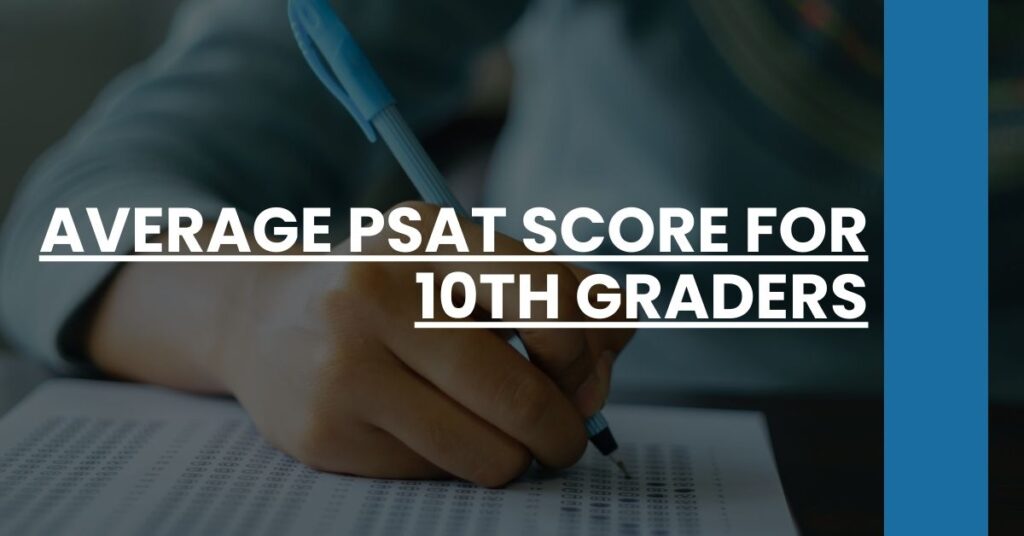For 10th graders eager to benchmark their academic progress, the PSAT serves as an early indicator, with an average score hovering around 920. This score assists students in gauging their readiness for college-level exams such as the SAT.
Highlighting the Average PSAT Score for 10th Graders:
- Reflects on college admission test preparedness
- Opens doors to scholarship opportunities like the National Merit Scholarship
- Offers a baseline for personalized improvement strategies
Read on to find out how your PSAT score compares to national percentiles and learn strategic steps to elevate your performance for future academic success.
- Significance of the PSAT for 10th Graders
- What is the PSAT?
- Average Scores and National Percentiles
- How to Interpret Your PSAT Score Report
- Benchmark for College Readiness
- Strategies to Improve PSAT Scores
- PSAT and Scholarship Opportunities
- FAQs About PSAT for 10th Graders
- Conclusion: Embracing the PSAT As a Stepping Stone
Significance of the PSAT for 10th Graders
As a 10th grader, taking the Preliminary SAT (PSAT) marks a significant milestone in your academic journey. While it’s natural to ask why this test matters, it’s important to understand the multifaceted role it plays in laying the foundation for your college admissions tests and beyond.
The PSAT is not just a practice run for the SAT; it’s a vital tool for pinpointing areas where you can improve. It gives you a realistic preview of the SAT format and content, allowing you to familiarize yourself with the types of questions you’ll encounter later. Based on your performance, you’ll also be able to craft a targeted study plan to bolster your strengths and address your weaknesses before facing the full-fledged SAT.
Moreover, the PSAT serves as a gateway to opportunities such as the National Merit Scholarship Program. Securing a score in the top percentile can put you in the running for scholarships that will be invaluable when it comes to financing your college education. Learn more about how your PSAT performance could potentially unlock scholarship doors by visiting The Princeton Review.
What is the PSAT?
Before delving into scores, let’s break down what constitutes the PSAT. This standardized test encompasses three key areas: reading, writing, and math—and it’s all about gauging your skills to successfully navigate college-level work. You won’t be penalized for wrong answers, so it’s in your interest to give every question your best shot.
The PSAT you take as a 10th grader is formally known as the PSAT 10. It’s specially tailored for your grade level, and while it mirrors the SAT in content and structure, it’s calibrated to the learning you’ve accomplished by sophomore year. For a closer look at what you’re stepping into, check out Albert.io’s detailed breakdown of the PSAT’s nuts and bolts.
Average Scores and National Percentiles
Your PSAT score is a numerical reflection of your proficiency across different academic domains. When you hear about the average PSAT score for 10th graders, it’s a benchmark that helps gauge how you stand in relation to your peers nationwide.
The scoring scale of the PSAT ranges from 320 to 1520. For 10th graders, the average score hovers around 920, which aligns with the midpoint, the 50th percentile, meaning half of the students scored below this number and half scored above. Reaching or surpassing this average score can be a promising sign of your potential performance on the SAT.
Understanding national percentiles can be pivotal. If your score lands in the 70th percentile, for instance, you’ve outperformed 70% of test takers. While the average score offers one insight, your national percentile provides another layer of context. To see where your score stands, the College Board provides a comprehensive explanation.
How to Interpret Your PSAT Score Report
Receiving your PSAT score report is both an informative and exhilarating experience. This detailed document goes beyond just a numeric score. It includes a range of insights tailored to help you understand your academic standing and areas for growth.
- Total Score: Your total score is the combined result of your Math and Evidence-Based Reading and Writing scores.
- Section Scores: You’ll receive individual scores for both the Math and the Evidence-Based Reading and Writing sections, giving you a clear picture of where your strengths lie.
- Test Scores: Even more granular, your report will break down your performance on individual tests within the larger sections, illuminating specific skills you might need to improve.
- Cross-Test Scores: These scores showcase your ability to apply your reading, writing, and math skills in scenarios that reflect the real world and the kind of thinking you’ll do at college.
- Subscores: Lastly, subscores provide insight into your competency in certain skill areas within the test sections, such as command of evidence or algebra.
Each of these components contributes to a holistic view of your academic readiness. They aid in crafting a personalized path for enhancement, emphasizing the importance of directing your efforts effectively. To further decipher each aspect of your PSAT score report, powerful resources and explanations are available at College Board’s Understanding PSAT Scores.
Your score report isn’t just a number—it’s a map for your educational journey ahead, highlighting the terrain you’ve mastered and the areas you’ve yet to explore.
Benchmark for College Readiness
The College Board has established specific College Readiness Benchmarks that offer insight into your potential for success in college-level coursework. If your PSAT score meets or exceeds these benchmarks, you’re considered on track to handle the rigors of college classes. The benchmarks differ for each grade and testing period, reflecting the growth and learning that happens from year to year.
Let’s say you’re a sophomore—your benchmark scores on the PSAT will be lower than those of juniors, as expected given the additional year of learning juniors have had. Specifically, for 10th graders, the College Readiness Benchmarks are set at:
- Evidence-Based Reading and Writing: 430
- Math: 480
If your score falls below these figures, it doesn’t mean college is out of reach—far from it. Rather, this information helps you identify where you might need extra practice. For a deeper dive into the College Readiness Benchmarks, the College Board provides plentiful resources on Understanding Scores.
Remember, your PSAT performance is a starting line, not the finish. It signals areas for growth, encouraging you to aim higher as you prepare for college.
Strategies to Improve PSAT Scores
Even if your score didn’t quite hit the average PSAT score for 10th graders, there’s ample room for improvement—and now is the perfect time to start. Here’s a strategic game plan to get your score on an upward trajectory:
- Establish a Study Schedule: Consistency is key. Set aside dedicated study times each week, and stick to them.
- Target Your Weaknesses: Analyze your PSAT score report to pinpoint the areas needing the most attention.
- Utilize Free Resources: Online platforms like Khan Academy provide tailored SAT prep that can bolster your PSAT scores since the two tests are closely aligned.
- Take Practice Tests: Familiarity breeds comfort. The more you simulate the test environment with practice exams, the more confident you’ll be on test day.
- Review Fundamentals: Refresh your understanding of key concepts, especially in math and grammar, areas where small errors can significantly impact your score.
- Seek Guidance: Don’t hesitate to ask for help. Whether it’s reaching out to a teacher or hiring a tutor, extra support can make a big difference.
- Stay Positive and Proactive: Embrace the challenge. Each study session is a step closer to your goal.
If you methodically follow through with these strategies, not only can you surpass the average PSat score for 10th graders, but you might also position yourself within the upper percentiles. To find inspiration from others who have successfully improved their scores, visit the College Confidential forum discussions, like Realistic PSAT Improvement.
PSAT and Scholarship Opportunities
Achieving a solid PSAT score is not only about academic pride; it opens the door to scholarship programs that can significantly ease the financial burden of college. One of the most notable is the National Merit Scholarship Program, which uses PSAT scores as part of its qualification criteria. Excelling on your PSAT can place you in contention for this prestigious recognition, but it requires scoring in the top percentile of test-takers.
The National Merit Scholarship is only the beginning. There are numerous other scholarships and recognition programs that factor in PSAT scores. To uncover the myriad opportunities your PSAT score can lead to, explore the resource at Learnt.io. It’s not just about meeting the average; it’s about using your score as a springboard to greater academic and financial opportunities.
FAQs About PSAT for 10th Graders
You likely have a host of questions about the PSAT. Let’s tackle some of the most common ones so you can better understand this crucial test and what it means for your academic trajectory:
- When should I take the PSAT? Typically, 10th graders take the PSAT in the fall. It’s the preliminary step before the PSAT/NMSQT, which is taken in 11th grade and considered for National Merit distinction.
- Should I prepare for the PSAT? Absolutely. While the PSAT doesn’t count towards college admissions, preparing for it can give you a head start on the SAT and boost your chances for scholarships.
- Can I retake the PSAT? Yes, students often take the PSAT more than once, typically in both 10th and 11th grades.
- How does the PSAT compare to the SAT? The PSAT and SAT have similar content and structure, but the SAT is slightly longer and more complex, reflecting the higher level of learning expected by 11th grade.
Conclusion: Embracing the PSAT As a Stepping Stone
Viewing the PSAT as a mere preliminary test underestimates its value. Surpassing the average PSAT score for 10th graders might be an initial goal, but the true reward of this test is the foundation it lays for future success. It’s a stepping stone in the grand scheme of your educational journey—a journey ripe with opportunities for growth, discovery, and scholarship.
Remember, your PSAT score is not a final verdict on your academic abilities; it’s an insightful metric pointing you towards areas where you can shine brighter. Whether you’re celebrating your score achievements or strategizing for better results, every step forward is progress. Embrace the PSAT, harness your learning experiences, and let them propel you toward the incredible potential of your high school years and beyond.

